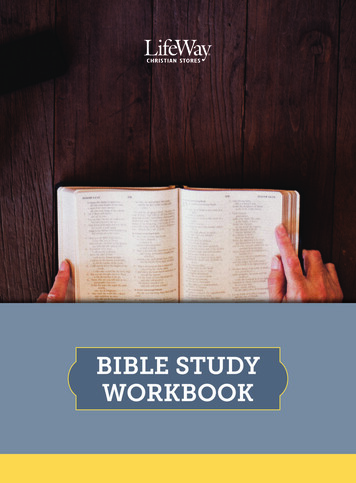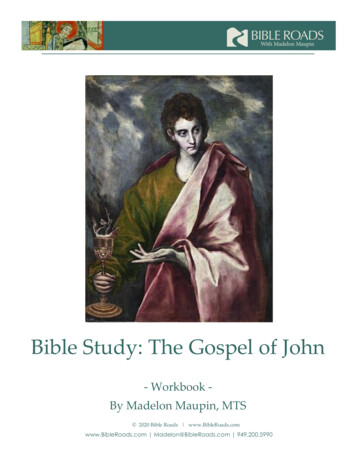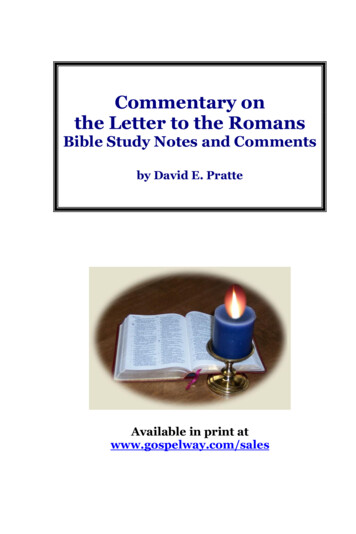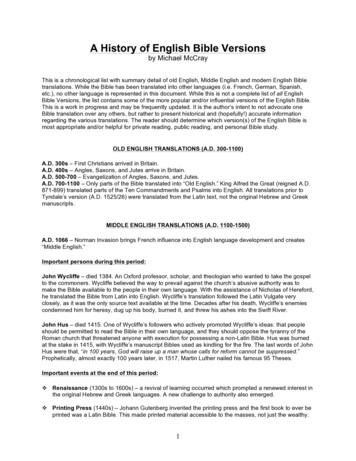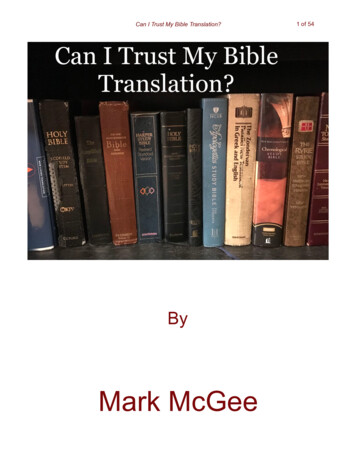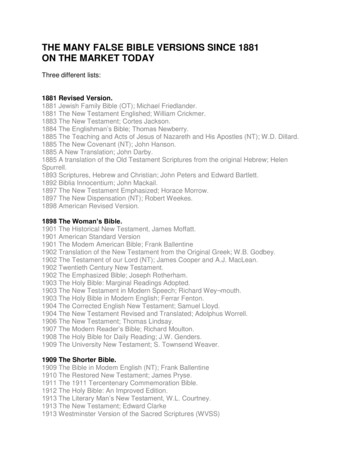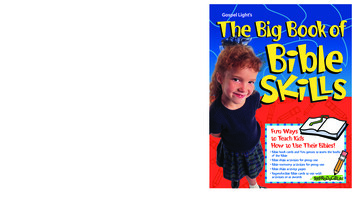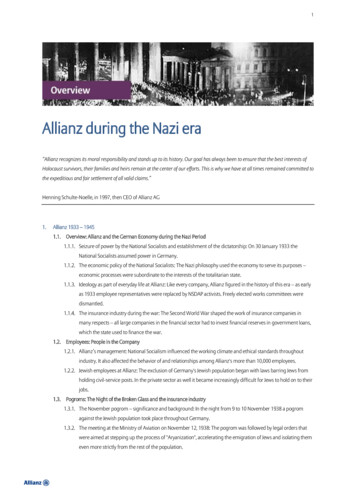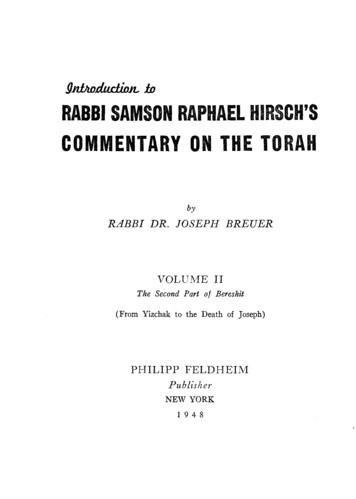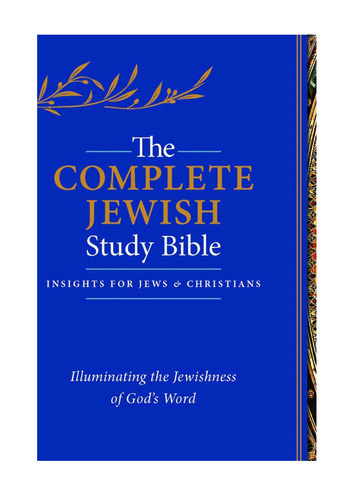
Transcription
The Complete Jewish Study Bible 2016 by Hendrickson Publishers Marketing, LLCP.O. Box 3473Peabody, Massachusetts 61970-870-9Hard CoverBlue FlexisoftBlack Genuine Calfskin LeatherThe Complete Jewish Study Bible, copyright 2016 by Hendrickson Publishers Marketing, LLC.All rights reserved.Complete Jewish Bible, copyright 1998 by David H. Stern. All rights reserved.Complete Jewish Bible, updated edition copyright 2016 by David H. Stern. All rights reserved.The CJB text may be quoted in any form (written, visual, electronic, or audio), up to and inclusive of fivehundred (500) verses without the express written permission of the publisher, provided that the versesquoted do not constitute a complete book nor account for twenty-five percent (25%) or more of the totaltext of the work in which they are quoted. Full attribution must be given on the copyright page as follows:Scripture quotations taken from the Complete Jewish Bible,Copyright 1998 and 2016 by David H. Stern.Used by permission. All rights reserved worldwide.Interior typesetting by Yvonne Vermillion, Magic Graphix, Westfork, Arkansas.Cover design and interior art direction by Karol Bailey.Biblical book introductions and color maps copyright 2016 by Hendrickson Publishers.Extrabiblical material supplied by Messianic Jewish Publishers and edited by Rabbi Barry A. Rubin.Project direction and research provided by Rabbi Barry A. Rubin, Rabbi Dr. John Fischer, Rick Brown,Michelle Rapkin, and Patricia Anders.Cover, introductions, and track article design artwork: Photograph iStock.com/Ioan Florin Cnejevici.Images are from the Cetate Synagogue in Timisoara, Romania. Built between 1863 and 1865 in Moorishstyle, it is listed as a historical monument.Cover and topical article (olive branch) design artwork: iStock.com/Diane Labombarbe.Printed in ItalyFirst printing—September 2016
ContentsBooks of the Tanakh Listed in Christian Old Testament Order . . . . . . . . . . . . . . . . . . . . . . . xBooks of the Bible Listed in Alphabetical Order . . . . . . . . . . . . . . . . . . . . . . . . . . . . . . . . . . . . xAbbreviations . . . . . . . . . . . . . . . . . . . . . . . . . . . . . . . . . . . . . . . . . . . . . . . . . . . . . . . . . . . . . . . . xiiMishnah, Talmud, and Other Works . . . . . . . . . . . . . . . . . . . . . . . . . . . . . . . . . . . . . . . . . . . . xiiiIntroduction to The Complete Jewish Study BibleFrom the General Editor . . . . . . . . . . . . . . . . . . . . . . . . . . . . . . . . . . . . . . . . . . . . . . . . . . . . . . xviiFeatures Unique to The Complete Jewish Study Bible . . . . . . . . . . . . . . . . . . . . . . . . . . . . . . xxiiINTRODUCTION TO THE COMPLETE JEWISH V.XV.XVI.XVII.XVIII.How the Complete Jewish Bible Came to Be. . . . . . . . . . . . . . . . . . . . . . . . . . . . . . . xxiiiTranslations and Translators . . . . . . . . . . . . . . . . . . . . . . . . . . . . . . . . . . . . . . . . . . . . xxvThe Bible . . . . . . . . . . . . . . . . . . . . . . . . . . . . . . . . . . . . . . . . . . . . . . . . . . . . . . . . . . . xxviiiContents of the Bible. . . . . . . . . . . . . . . . . . . . . . . . . . . . . . . . . . . . . . . . . . . . . . . . . . xxxiOther Features of the Bible . . . . . . . . . . . . . . . . . . . . . . . . . . . . . . . . . . . . . . . . . . . xxxivWhy the Bible Is God’s Word . . . . . . . . . . . . . . . . . . . . . . . . . . . . . . . . . . . . . . . . . . . xxixJewish Tanakh versus Christian Old Testament . . . . . . . . . . . . . . . . . . . . . . . . . . xxxviOriginal-Language Texts Underlying the Complete Jewish Bible . . . . . . . . . . . xxxviiiPoetry in the Complete Jewish Bible . . . . . . . . . . . . . . . . . . . . . . . . . . . . . . . . . . . . . . . xliThe Name of God in the Complete Jewish Bible . . . . . . . . . . . . . . . . . . . . . . . . . . . . xliiThe Jewishness of the New Testament . . . . . . . . . . . . . . . . . . . . . . . . . . . . . . . . . . . . xlivHow the Complete Jewish Bible Expresses the B’rit Hadashah’s Jewishness . . . . xlviiReasons for Certain B’rit Hadashah Renderings . . . . . . . . . . . . . . . . . . . . . . . . . . . . xlixTanakh Prophecies Fulfilled by Yeshua the Messiah . . . . . . . . . . . . . . . . . . . . . . . . . . liSynagogue Usage of the Complete Jewish Bible . . . . . . . . . . . . . . . . . . . . . . . . . . . . . . .lvHow to Pronounce the Hebrew Names and Terms . . . . . . . . . . . . . . . . . . . . . . . . . lviiUsing the Complete Jewish Bible . . . . . . . . . . . . . . . . . . . . . . . . . . . . . . . . . . . . . . . . . . .lxAcknowledgments . . . . . . . . . . . . . . . . . . . . . . . . . . . . . . . . . . . . . . . . . . . . . . . . . . . . . lxiiBOOKS OF THE BIBLE BY SECTIONi. torah (teaching, law)B’resheet (Genesis) . . . . . . . . . . . . . . . . . . . . . . . . . . . . . . . . . . . . . . . . . . . . . . . . . . . . . . . . 1Sh’mot (Exodus) . . . . . . . . . . . . . . . . . . . . . . . . . . . . . . . . . . . . . . . . . . . . . . . . . . . . . . . . . 70Vayikra (Leviticus) . . . . . . . . . . . . . . . . . . . . . . . . . . . . . . . . . . . . . . . . . . . . . . . . . . . . . 129B’midbar (Numbers) . . . . . . . . . . . . . . . . . . . . . . . . . . . . . . . . . . . . . . . . . . . . . . . . . . . . 171D’varim (Deuteronomy) . . . . . . . . . . . . . . . . . . . . . . . . . . . . . . . . . . . . . . . . . . . . . . . . . 225
viii CONTENTSii. nevi’im (prophets)Nevi’im Rishonim (Early Prophets)Y’hoshua (Joshua) . . . . . . . . . . . . . . . . . . . . . . . . . . . . . . . . . . . . . . . . . . . . . . . . . . . . 275Shof ’tim (Judges) . . . . . . . . . . . . . . . . . . . . . . . . . . . . . . . . . . . . . . . . . . . . . . . . . . . . . 305Sh’mu’el (Samuel)Sh’mu’el Alef (1 Samuel) . . . . . . . . . . . . . . . . . . . . . . . . . . . . . . . . . . . . . . . . . . . . . . . 335Sh’mu’el Bet (2 Samuel) . . . . . . . . . . . . . . . . . . . . . . . . . . . . . . . . . . . . . . . . . . . . . . . . 374M’lakhim (Kings)M’lakhim Alef (1 Kings) . . . . . . . . . . . . . . . . . . . . . . . . . . . . . . . . . . . . . . . . . . . . . . . 410M’lakhim Bet (2 Kings) . . . . . . . . . . . . . . . . . . . . . . . . . . . . . . . . . . . . . . . . . . . . . . . . 446Nevi’im Acharonim (Later Prophets)Yesha‘yahu (Isaiah) . . . . . . . . . . . . . . . . . . . . . . . . . . . . . . . . . . . . . . . . . . . . . . . . . . . 482Yirmeyahu (Jeremiah). . . . . . . . . . . . . . . . . . . . . . . . . . . . . . . . . . . . . . . . . . . . . . . . . 606Yechezk’el (Ezekiel). . . . . . . . . . . . . . . . . . . . . . . . . . . . . . . . . . . . . . . . . . . . . . . . . . . . 713Shneim-‘Asar (The Twelve)Hoshea (Hosea) . . . . . . . . . . . . . . . . . . . . . . . . . . . . . . . . . . . . . . . . . . . . . . . . . . . . . . 785Yo’el (Joel) . . . . . . . . . . . . . . . . . . . . . . . . . . . . . . . . . . . . . . . . . . . . . . . . . . . . . . . . . . . 804‘Amos (Amos) . . . . . . . . . . . . . . . . . . . . . . . . . . . . . . . . . . . . . . . . . . . . . . . . . . . . . . . . 813‘Ovadyah (Obadiah) . . . . . . . . . . . . . . . . . . . . . . . . . . . . . . . . . . . . . . . . . . . . . . . . . . 828Yonah (Jonah) . . . . . . . . . . . . . . . . . . . . . . . . . . . . . . . . . . . . . . . . . . . . . . . . . . . . . . . 832Mikhah (Micah) . . . . . . . . . . . . . . . . . . . . . . . . . . . . . . . . . . . . . . . . . . . . . . . . . . . . . . 837Nachum (Nahum) . . . . . . . . . . . . . . . . . . . . . . . . . . . . . . . . . . . . . . . . . . . . . . . . . . . . 850Havakuk (Habakkuk) . . . . . . . . . . . . . . . . . . . . . . . . . . . . . . . . . . . . . . . . . . . . . . . . . 856Tz’fanyah (Zephaniah) . . . . . . . . . . . . . . . . . . . . . . . . . . . . . . . . . . . . . . . . . . . . . . . . 863Hagai (Haggai) . . . . . . . . . . . . . . . . . . . . . . . . . . . . . . . . . . . . . . . . . . . . . . . . . . . . . . . 870Z’kharyah (Zechariah) . . . . . . . . . . . . . . . . . . . . . . . . . . . . . . . . . . . . . . . . . . . . . . . . 874Mal’akhi (Malachi) . . . . . . . . . . . . . . . . . . . . . . . . . . . . . . . . . . . . . . . . . . . . . . . . . . . 891iii. k’tuvim (writings)Tehillim (Psalms) . . . . . . . . . . . . . . . . . . . . . . . . . . . . . . . . . . . . . . . . . . . . . . . . . . . . . 898Mishlei (Proverbs) . . . . . . . . . . . . . . . . . . . . . . . . . . . . . . . . . . . . . . . . . . . . . . . . . . . 1062Iyov (Job) . . . . . . . . . . . . . . . . . . . . . . . . . . . . . . . . . . . . . . . . . . . . . . . . . . . . . . . . . . 1118The Five Megillot (Scrolls)Shir-HaShirim (Song of Songs) . . . . . . . . . . . . . . . . . . . . . . . . . . . . . . . . . . . . . . . . 1177Rut (Ruth). . . . . . . . . . . . . . . . . . . . . . . . . . . . . . . . . . . . . . . . . . . . . . . . . . . . . . . . . . 1189Eikhah (Lamentations) . . . . . . . . . . . . . . . . . . . . . . . . . . . . . . . . . . . . . . . . . . . . . . . 1196Kohelet (Ecclesiastes) . . . . . . . . . . . . . . . . . . . . . . . . . . . . . . . . . . . . . . . . . . . . . . . . 1211Ester (Esther) . . . . . . . . . . . . . . . . . . . . . . . . . . . . . . . . . . . . . . . . . . . . . . . . . . . . . . . 1228Dani’el (Daniel) . . . . . . . . . . . . . . . . . . . . . . . . . . . . . . . . . . . . . . . . . . . . . . . . . . . . . 1240‘Ezra-Nechemyah (Ezra-Nehemiah)‘Ezra (Ezra) . . . . . . . . . . . . . . . . . . . . . . . . . . . . . . . . . . . . . . . . . . . . . . . . . . . . . . . 1262Nechemyah (Nehemiah) . . . . . . . . . . . . . . . . . . . . . . . . . . . . . . . . . . . . . . . . . . . . 1279Divrei-HaYamim (Chronicles)Divrei-HaYamim Alef (1 Chronicles) . . . . . . . . . . . . . . . . . . . . . . . . . . . . . . . . . 1301Divrei-HaYamim Bet (2 Chronicles) . . . . . . . . . . . . . . . . . . . . . . . . . . . . . . . . . . 1336iv. the good news of yeshua the messiah, as reported byMattityahu (Matthew) . . . . . . . . . . . . . . . . . . . . . . . . . . . . . . . . . . . . . . . . . . . . . . . . . 1379Mark . . . . . . . . . . . . . . . . . . . . . . . . . . . . . . . . . . . . . . . . . . . . . . . . . . . . . . . . . . . . . . . . 1439Luke. . . . . . . . . . . . . . . . . . . . . . . . . . . . . . . . . . . . . . . . . . . . . . . . . . . . . . . . . . . . . . . . . 1468Yochanan (John) . . . . . . . . . . . . . . . . . . . . . . . . . . . . . . . . . . . . . . . . . . . . . . . . . . . . . . 1517
C O N T E N T S ixv. the acts of the emissaries of yeshua the messiah. . . . . . . . . . . . . . . . . . . . 1557vi. letters/epistlesSha’ul’s (Paul’s) Letters to CommunitiesRomans . . . . . . . . . . . . . . . . . . . . . . . . . . . . . . . . . . . . . . . . . . . . . . . . . . . . . . . . . . . . 16041 Corinthians . . . . . . . . . . . . . . . . . . . . . . . . . . . . . . . . . . . . . . . . . . . . . . . . . . . . . . . 16312 Corinthians . . . . . . . . . . . . . . . . . . . . . . . . . . . . . . . . . . . . . . . . . . . . . . . . . . . . . . . 1654Galatians . . . . . . . . . . . . . . . . . . . . . . . . . . . . . . . . . . . . . . . . . . . . . . . . . . . . . . . . . . . 1668Ephesians . . . . . . . . . . . . . . . . . . . . . . . . . . . . . . . . . . . . . . . . . . . . . . . . . . . . . . . . . . 1678Philippians . . . . . . . . . . . . . . . . . . . . . . . . . . . . . . . . . . . . . . . . . . . . . . . . . . . . . . . . . 1687Colossians. . . . . . . . . . . . . . . . . . . . . . . . . . . . . . . . . . . . . . . . . . . . . . . . . . . . . . . . . . 16931 Thessalonians . . . . . . . . . . . . . . . . . . . . . . . . . . . . . . . . . . . . . . . . . . . . . . . . . . . . . 17002 Thessalonians . . . . . . . . . . . . . . . . . . . . . . . . . . . . . . . . . . . . . . . . . . . . . . . . . . . . . 1705Sha’ul’s (Paul’s) Pastoral Letters (to Individuals)1 Timothy . . . . . . . . . . . . . . . . . . . . . . . . . . . . . . . . . . . . . . . . . . . . . . . . . . . . . . . . . . 17092 Timothy . . . . . . . . . . . . . . . . . . . . . . . . . . . . . . . . . . . . . . . . . . . . . . . . . . . . . . . . . . 1716Titus . . . . . . . . . . . . . . . . . . . . . . . . . . . . . . . . . . . . . . . . . . . . . . . . . . . . . . . . . . . . . . 1721Philemon . . . . . . . . . . . . . . . . . . . . . . . . . . . . . . . . . . . . . . . . . . . . . . . . . . . . . . . . . . 1725Messianic LettersMessianic Jews (Hebrews) . . . . . . . . . . . . . . . . . . . . . . . . . . . . . . . . . . . . . . . . . . . . 1728Ya‘akov (James) . . . . . . . . . . . . . . . . . . . . . . . . . . . . . . . . . . . . . . . . . . . . . . . . . . . . . 17501 Kefa (1 Peter) . . . . . . . . . . . . . . . . . . . . . . . . . . . . . . . . . . . . . . . . . . . . . . . . . . . . . 17572 Kefa (2 Peter) . . . . . . . . . . . . . . . . . . . . . . . . . . . . . . . . . . . . . . . . . . . . . . . . . . . . . 17641 Yochanan (1 John) . . . . . . . . . . . . . . . . . . . . . . . . . . . . . . . . . . . . . . . . . . . . . . . . . 17692 Yochanan (2 John) . . . . . . . . . . . . . . . . . . . . . . . . . . . . . . . . . . . . . . . . . . . . . . . . . 17763 Yochanan (3 John) . . . . . . . . . . . . . . . . . . . . . . . . . . . . . . . . . . . . . . . . . . . . . . . . . 1778Y’hudah (Jude) . . . . . . . . . . . . . . . . . . . . . . . . . . . . . . . . . . . . . . . . . . . . . . . . . . . . . . 1780vii. the revelation of yeshua the messiah to yochanan (john) . . . . . . . . . . 1783APPENDIXGlossary of Hebrew Words (with Pronunciation) into English . . . . . . . . . . . . . . . . . . . . . 1813Glossary of English Words into Hebrew (with Pronunciation) . . . . . . . . . . . . . . . . . . . . . 1861Index of Tanakh Passages Cited in the B’rit Hadashah . . . . . . . . . . . . . . . . . . . . . . . . . . . . 1865Scripture Readings for Shabbat and Festivals, Feasts & Fasts . . . . . . . . . . . . . . . . . . . . . . 1873Shabbat Scripture Readings (Parashot) . . . . . . . . . . . . . . . . . . . . . . . . . . . . . . . . . . . 1874Festivals, Feasts & Fasts Scripture Readings . . . . . . . . . . . . . . . . . . . . . . . . . . . . . . . 1878Topical Articles Index . . . . . . . . . . . . . . . . . . . . . . . . . . . . . . . . . . . . . . . . . . . . . . . . . . . . . . . 1881Theme Articles Index . . . . . . . . . . . . . . . . . . . . . . . . . . . . . . . . . . . . . . . . . . . . . . . . . . . . . . . 1883Biographies of Rabbis and Sages . . . . . . . . . . . . . . . . . . . . . . . . . . . . . . . . . . . . . . . . . . . . . . 1886Contributors . . . . . . . . . . . . . . . . . . . . . . . . . . . . . . . . . . . . . . . . . . . . . . . . . . . . . . . . . . . . . . . 1895Works Cited and Further Reading . . . . . . . . . . . . . . . . . . . . . . . . . . . . . . . . . . . . . . . . . . . . . 1898About the Translator . . . . . . . . . . . . . . . . . . . . . . . . . . . . . . . . . . . . . . . . . . . . . . . . . . . . . . . . 1905Maps . . . . . . . . . . . . . . . . . . . . . . . . . . . . . . . . . . . . . . . . . . . . . . . . . . . . . . . . . . . . . . . . . . . . . . 1907
The Complete Jewish Study Bibleintroduction ToFrom The General EditorYou hold in your hands a book that will open your eyes to the Bible as never before.You may have heard something like this previously, so you might be wondering how I canmake such a bold claim. The answer is that this study Bible contains information fromJewish sources to explain a thoroughly Jewish book—the Bible—written by Jews, about Jews,initially for Jews in the Jewish Land of Israel.This study Bible contains the newly updated Complete Jewish Bible (CJB), the standardfor all Bible texts that restore the original and essential “Jewishness” to God’s word. Whyis that so important? After centuries of translations from Hebrew and Greek into Englishand other languages, nuances and even accurate meanings are lost. In one critical example,the original Jewish form of Messiah’s name—Yeshua—is used in this Bible instead of theGreek translation, Jesus. Of course, there’s nothing inherently wrong in saying “Jesus,” butit’s not how he was known to his family, friends, and first-century followers. To them, hewas Yeshua, a Hebrew name meaning “salvation.” Since Hebrew names were often given toreflect something about the person, what better name could he be given? Reading the Biblein this way increases understanding.Since all translations use transliterations for non-Hebrew speaking readers, the CJBdoes so as well. Only, they are truer to the Hebrew text. For example, instead of referringto the mysterious person in Genesis 14 as Melchizedek, as most Bibles render his name(a transliteration of Hebrew letters), the CJB presents this name as Malki-Tzedek, whichmeans “my king is righteous” or “king of righteousness.” Ever so subtly, a reader begins tounderstand the language Yeshua spoke. There are thousands of words in the CJB like this,reminding the reader that the Bible was written entirely by Jews (yes, even Luke was mostlikely Jewish, as you will discover in The Complete Jewish Study Bible).In this updated Complete Jewish Bible, we have increased the English definitions ofHebrew transliterated words (in parentheses) presented, along with the word itself. Thusyou will see that Eve is really “Havah,” which means “life.” Obviously, since this is not aninterlinear Bible, we couldn’t do this for all Hebrew or Greek words, so we chose those wordswe thought would be most meaningful to you.Another update to the Complete Jewish Bible is the removal of all Yiddish words (suchas tsuris), replacing them with English equivalents (in this case, “troubles”). We felt thatalthough using Yiddish (the language of Eastern European Jews, which combines Hebrewand German) was a way to reinforce just how Jewish the Bible is, it made the text moredifficult to read and understand. Many of our loyal readers requested this. This also makesthe text more credible in the academic world.All Bible teachers would say that to truly understand God’s word, the context of thewords must be understood, as well as the technical meaning of the word itself. For example,how can we understand what “born again” fully means unless we know how the expressionwas used in the Second Temple era, the time of Yeshua? This rabbinic expression used by
xviii INTRODUC TION TO THE COMPLETE JEWISH STUDY BIBLEMessiah (Yochanan/John 3:3) has levels of meanings. So The Complete Jewish Study Bible(CJSB) includes an excellent article on this term, as well as other numerous short articles tohelp the reader understand the Bible better. Many of these articles are from books publishedby Messianic Jewish Publishers and other similar sources, which—like the CJB—are usefulin presenting a fuller picture of God’s word.But not all the content in the CJSB comes from Messianic Jews. Some of the bottomof-the-page notes are supplied by Christian theologians who have an understanding of thehistory and culture of ancient Israel. We’re particularly grateful to Dr. Forrest Weiland—former professor of Old Testament at Bethel Seminary, now professor of biblical studies atVeritas Evangelical Seminary—for allowing us to use his lecture notes from his classes.We also use a source that is generally not accessible to most people unless they areOrthodox Jews or Bible scholars—that is, we quote from the Talmud (the collection ofrabbinic writings on the Tanakh/Old Testament, existent during the Second Templeera). We also include content from the major rabbis and Jewish scholars for the past twomillennia. Although some people might think it is inappropriate to include the writingsof non-Messianic Jews, the thoughts of these rabbis and sages add rich meaning andapplication to the notes. After all, who better to discuss the Tanakh than Jews steeped inHebrew and deeply engaged in understanding the text? I think you will find these commentsto be quite meaningful.A few words of thanks. In the back of this Bible, you will find a list of those who eitherdirectly contributed content to the CJSB or who were quoted in it. They have made the CJSBthe valuable work that it is. I also want to thank Rabbi Mark Rantz, who assisted me byfinding many of the Jewish sources added to this book, as well as helping with some of theadministrative details. Others in my publishing organization were instrumental in gettingthis book finished, especially my wife, Lisa.Rabbi Dr. John Fischer, the theological editor, read nearly 100 percent of the articlesand notes to check for accuracy and correctness. Additionally, John and his wife, Dr. PatriceFischer, were involved at the outset of this project, along with Drs. Bruce Stokes and DavidFriedman. I also want to mention Rabbi David Rosenberg and his entire family, who havebeen perhaps the biggest “fans” of the CJB, going back to when Dr. Stern translated theJewish New Testament in 1989. I should also thank Rick Brown, publisher at HendricksonPublishers, for his patience and organizational skill, as well as his team of scholars andeditors who vetted the CJSB, and the graphic artists who designed the page layout andcover, and for also providing the colorful maps that enrich this work. Also, Patricia Klein,may she rest in peace, was instrumental at the outset of this project and connected me toHendrickson Publishers. She was a good friend of both mine and Rick Brown.Last, but certainly not least, we are all thankful to the God of Abraham, Isaac, and Jacoband his Messiah, Yeshua, who made all this possible.Rabbi Barry Rubin, General EditorApril 2016
Features Unique toThe Complete Jewish Study BibleNew Bible Book Introductions. The Complete Jewish Study Bible includes new Bible bookintroductions written from a Jewish perspective.Study Notes. Exclusive to The Complete Jewish Study Bible are extensive bottom-of-pagestudy notes to help readers understand the deeper meanings behind the Jewish text.List of Contributors. Twenty-five contributors (both Jewish and Christian), including JohnFischer, Patrice Fischer, Arnold G. Fruchtenbaum, Rabbi Russell Resnick, and many more.Colorful Maps. Includes eight full color maps.Topical ArticlesAlso exclusive to The Complete Jewish StudyBible are a number of helpful articles to aid thereader in understanding the Jewish context for theScriptures, both in the Tanakh (the Old Testament)and the B’rit Hadashah (the New Testament). Thereare thirty-four topical articles ranging from topicssuch as the menorah (or “candelabra of God”) andrepentance (t’shuvah) in the Bible, to Yeshua’s“Sermon on the Mount” and the Noachide Laws(the laws given by God to Noah and subsequentgenerations) and their applicability to Gentiles.Theme Articles. In addition to the topical articles and detailed study notes, there are twelvethemes (described below) running throughout The Complete Jewish Study Bible with 117insightful articles.ANTI-JEWISH SCRIPTURAL INTERPRETATIONSSome scholars trace modern anti-Semitism tomisinterpretations of some of the words in theNew Testament. While it is true that anti-Semitismdoes exist, it is inaccurate to assert that it finds itsorigins in the writings of God’s emissaries (apostles).Although the New Testament records an often hostileJewish family debate (which has been misusedfor anti-Semitic purposes), if we correctly read itwithin its proper framework, we can easily identifyits Jewishness. Through a correct understandingof history and biblical hermeneutics, the reader ofthe New Testament will find an elevation of Isra’el,Judaism, and Torah observance.
xx F E AT U R E S U N I Q U E T O T H E C O M P L E T E J E W I S H S T U D Y B I B L ECOVENANTSIn the Scriptures, God establishes four covenants:with Noach (Noah) after the Flood, Avraham(Abraham), Moshe (Moses) at Mount Sinai, and KingDavid. In Matthew 5:17–19, Yeshua says that untilheaven and earth pass away, the smallest letterwill not pass from the Torah until all is fulfilled. Godpromises that Isra’el will always remain a peoplebefore him. None of the covenants replace the others.They are dependent upon one another and arepresently in effect, finding their fulfillment in the newcovenant in Yeshua.JEWISH CUSTOMSWhile certain customs are usually identified as“Jewish” customs, they are in fact “biblical” customs.These traditions enrich and bless not only the Jewishpeople but any believer who seeks to embrace them.What better way to understand the Messiah than tostudy the context of his life on earth as a religious Jew?The first followers of Yeshua, nearly all Jews, did notabandon their traditions and practices, and neitherdid Yeshua. The biblical customs Yeshua practiced areoften the missing key to unlocking the depths of theScriptures.JEWISH-GENTILE REL ATIONSIn Genesis 12:3, God promised to make Avraham andhis descendants (Isra’el) a blessing for the entire world,which was fulfilled in Messiah Yeshua. Yet many rejectthe notion of Isra’el as chosen in this unique way.Although nations have continuously sought to destroythe Jewish people, God’s hand has visibly been onthem, most notably in their contributions to humanity.Apart from the writers of the Bible—all of whomwere most likely Jewish—numerous Jews have made(and continue to make) enormous contributions intheir respective fields: philosophy, science, psychology,philanthropy, entertainment, and more.MESSIANIC PROPHECYThrough Isra’el’s prophets, God announced thecoming of his Messiah, his special anointed one,Yeshua. After Yeshua’s crucifixion and resurrection,when he was walking with the disciples on theEmmaus Road, he explained everything to themthrough “the things that can be found throughout theTanakh concerning himself” (Luke 24:27). Althoughthere are literally hundreds of texts from the Tanakhthat point to the Messiah, the articles in this Bible willfocus on the messianic prophecies that provide thefoundation of God’s program to bring blessing to hisworld through the Messiah.
F E AT U R E S U N I Q U E T O T H E C O M P L E T E J E W I S H S T U D Y B I B L E xxiTHE NAMES OF GODIn Hebrew thought, a name is a way of revealingsomeone’s very identity and essence. It is the same withthe name of God—only in Scripture, God’s identity isexpressed not just in one name but in many. The namesof God represent the Hebrew conception of the divinenature or character of God, as well as the relation ofGod to his people. They represent the deity as he isknown to his worshippers and reveal those attributeshe bears in relation to them, revealed through hisactivity on their behalf, as well as the rest of the world.THE SABBATH (SHABBAT)Shabbat means “rest,” which is the central theme ofthis important observance. From ancient to moderntimes, humans have always needed proper rest andrefreshment. In his infinite wisdom, God told thechildren of Isra’el to recharge themselves physically,emotionally, and spiritually. He demonstrated thisprinciple when he created the universe: for six dayshe formed the world and everything in it, but on theseventh day he rested. Consequently, the seventhday, Shabbat, is to be a perpetual reminder of God theCreator and our need to find rest, not just in generalbut in him as well (Exod. 31:16–17).SALVATION AND ATONEMENTGod’s plan has always been to be in communionwith humanity. Humans are “image-bearers” of God,called to find their identity and purpose in him. Yet,despite the perfection of their union with God in theGarden, Adam and Havah (Eve) were tempted andrejected the Lord’s commands. As he did for them withthe “garments of skin,” God has provided a covering(kapparah) for humanity’s nakedness, humanity’s sin.This covering was a symbol that through the sacrificesto come—and in the coming Messiah—humanitywould be freed from its brokenness, sin, and shame.THE HOLY DAYS OF ISRA’ ELAlthough the biblical holy days were first given toIsra’el, they are for all believers. The holy days are greatobject lessons from which to learn about God and hisplan for the world. Just as Pesach (Passover) is about theredemption and rescue brought to the Jewish slaves inEgypt, symbolized in the unleavened bread and wineused during the annual Passover Seder dinner, so too theregular remembrance of Yeshua’s sacrifice of his body andblood for salvation recounts God’s rescue of humanityfrom slavery to sin. The celebration of the Jewish holydays is intended as a reminder of God’s commands andinteraction with his people throughout history.
xxii F E AT U R E S U N I Q U E T O T H E C O M P L E T E J E W I S H S T U D Y B I B L ETHE L AND OF ISRA’ ELGod’s redemptive plan came through the Jewishpeople and is manifest in the Land of Isra’el (EretzIsra’el) and in Messiah Yeshua. God confirmed thepromise he made to Avraham (Abraham) and Yitz’chak(Isaac) when he said to Ya‘akov (Jacob), “The landon which you are lying I will give to you and to yourdescendants” (Gen. 28:13). The keeping of this promiseto Avraham and his descendants was never by the actor will of humans—only by the Lord, who fulfills hispromises to his people Isra’el and to all his people.TORAHIn covenantal faithfulness, God provided guidancefor his people and through them to all people. Thisinstruction is known as Torah and is necessary foran accurate understanding of the rest of Scripture.Although Torah is usually translated as “law,” it simplymeans “instruction” or “the way to go.” Yeshua is theliving Word who embodies the will of the Father, andthe Spirit guides his followers into all truth, enablingthem to observe God’s instructions. In his teachings,Yeshua confirmed the importance of Torah by stating,“Don’t think that I have come to abolish the Torahor the Prophets. I have come not to abolish but tocomplete” (Matt. 5:17).THE TABERNACLE (MISHKAN)Throughout Scripture, the Tabernacle (Mishkan) isa symbol of God’s perpetual desire to dwell with hispeople. While we might think that fellowship betweenhumanity and God began
make such a bold claim. The answer is that this study Bible contains information from Jewish sources to explain a thoroughly Jewish book—the Bible—written by Jews, about Jews, initially for Jews in the Jewish Land of Israel. This study Bible contains the newly updated Complete


